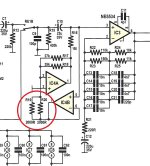No. Please read Douglas Self's book: Small Signal Audio Design, 2 Edition.
I mis-read the schematic from the Elektor article -- R19||R20 is 2k||2K not 200||200, so the gain was too, too high.
Attachments
A cartridge is a somewhat more complex model than you are assuming. Hans Polak did some measurements on another thread. Attached is an example of a fairly normal MM up to generator resonance.
Indeed, but that has only a limited impact on the effect of equivalent input noise current (such as the contribution to the equivalent input noise current made by the input termination resistor). It is mainly the thermal noise of the cartridge itself that you underestimate when you assume it to behave as the series connection of an ideal inductor and an ideal resistor (that is, have a constant effective series resistance), and of course you overestimate the Q factor of the resonance with the loading capacitor.
Marcel: I fully agree with you, but given we are in the 21st Century polishing effectively a 19th century poop* it's worth pointing out, esp with the power of simulators at our disposal, that the cartridge generator model is more complex that the textbook analysis and in some cases this does matter. I am very off piste with my experimentation so this does matter to me.
Interestingly of the cartridges tested, which was by no means a huge cross section the Denon DL-107 was closest to a series L+R.
*In case anyone doesn't know me I find vinyl huge fun for messing about with but accept the reality of its limitations.
Interestingly of the cartridges tested, which was by no means a huge cross section the Denon DL-107 was closest to a series L+R.
*In case anyone doesn't know me I find vinyl huge fun for messing about with but accept the reality of its limitations.
I mis-read the schematic....
Curiouser and curiouser. That gives gain of 15.96, so transformation of 14.95, making the 1Meg act like 66.87k. Is there a 158k nearby? I see a 430k but it's not adding-up for me.
I found the post from last year where Marcel and Hans were discussing this where the real power of synthetic loading was shown. Measuring phono stage RIAA accuracy with a computer
In this the cartridge was being loaded with 6K to give the 75us pole passively, which I think is a good thing. Now a passive 6k load gives a 7.6dB noise penalty over 47k which can be changed into a 1.3dB improvement with synthetic loading. To me this is a very nice trade off, although I full understand why it could never make it into a commercially sucessful product.
In this the cartridge was being loaded with 6K to give the 75us pole passively, which I think is a good thing. Now a passive 6k load gives a 7.6dB noise penalty over 47k which can be changed into a 1.3dB improvement with synthetic loading. To me this is a very nice trade off, although I full understand why it could never make it into a commercially sucessful product.
Off topic
Jan,
I have the complete article but it is not about audio, it is about extending an opamp's capabilities. The second page of the article is attached and the article is all about using the circuit of figure 3. Using this in the Hoeffelman-Meyes preamp circuit (see reference 7 of the article) was just an example. If you want the entire article tell me where to email it.
Jan,
I have the complete article but it is not about audio, it is about extending an opamp's capabilities. The second page of the article is attached and the article is all about using the circuit of figure 3. Using this in the Hoeffelman-Meyes preamp circuit (see reference 7 of the article) was just an example. If you want the entire article tell me where to email it.
Attachments
- Status
- This old topic is closed. If you want to reopen this topic, contact a moderator using the "Report Post" button.
- Home
- Source & Line
- Analogue Source
- Synthetic Cartridge Loading
